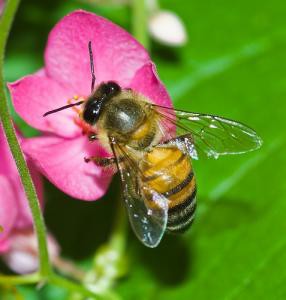Why we do not support the use of 1080: 
Currently, each year, more than four tonne of 1080, a deadly poison, is dumped over more than a million hectares of NZ’s bush, forests and farmland with the intention of killing possums that are damaging our native bush and birds.
We propose stopping the use of aerial 1080 poison drops in favour of less environmentally destructive pest control techniques.
For example, trapping can be done in many areas, and would not only provide employment in country areas, it could be the basis of a fur industry. While 1080 continues to be used, money is not being put into finding less environmentally damaging alternatives.
Death from 1080 poisoning typically involves nausea, vomiting, convulsions, pain and foaming of the mouth, and can take anywhere from 1-72 hrs, depending on the species and the dose. From an animal rights perspective, we should not be allowing such an extremely painful death. Possums stoats and rats are not the only animals to die this way. Other wild and domestic animals become unintended kill, and it persists through the food chain.
“1080 poison is now clearly associated with plagues of pests including stoats, rats and mice, that have devastating effects on native species. For example, a DoC employee reported in 2002: “Four months after an effective possum and rat knock-down by a 20,000-ha aerial 1080 operation over Tongariro Forest, stoats reappeared in the centre of the forest and began killing kiwi chicks.” See article by Dr Jo Pollard. This information seems to be being ignored, but realistically, if one species is destroyed it is only logical that another will take its place.
The effect of sub-lethal 1080 exposure on both humans and the environment has not been assessed, and there is concern that 1080 can enter the food chain and water supplies. So far, in spite of the lack of testing, there has been 50 years of poisoning. Is this going to continue for another 50 years?
We immediately need to find another solution.
Auckland Council has recently dropped 1080 in the Hunua Ranges, near the city’s water supply, and says it may even have to drop the poison more regularly. This is irresponsible because there has not been enough testing done to prove that 1080 is safe in such instances, given that there will be some inevitable contamination of the water supply.
Links to articles:
NZ Herald “Possum-killing questioned after no disease (TB) found.”
NZ Herald “Rolleston 1080 poison bait factory granted resource consent” April 24 2015
Marlbrough Express “Lobby wants traps not 1080” December 10 2013
Here is a damning web site from “independent” science, that tells of massive gaps in scientific testing for the safety of 1080.
The problem with Roundup 
“On March 20, the UK journal Lancet Oncology published the summary of a report by the World Health Organization’s International Agency for Research on Cancer (IARC) which classified glyphosate – the active ingredient in Monsanto’s Roundup and the world’s most widely-used herbicide – as “probably carcinogenic to humans.” With this report, the WHO explicitly recognizes the importance of independent research on the impact of pesticides on human health and the food chain – a field long dominated by pesticide manufacturers.” Source
There is independent science that indicates that Roundup is even more toxic than glyphosate itself, causing kidney disease, sex hormone disruption, congestion of the liver, and pituitary and endocrine disruption in rats.
All in all Roundup appears to cause severe metabolic consequences in the body and far more should have been known about it before it was released for general use.
Links to articles:
Scientific American “Weed-Whacking Herbicide Proves Deadly to Human Cells”
“World’s First Public Testing for Monsanto’s Glyphosate Begins Today. Could ban Roundup!”
“Roundup is endocrine disruptor in human cells at levels allowed in drinking water”
What is killing the bees? 
Neonicotinoids are a relatively new class of insecticides that share a common mode of action that affect the central nervous system of insects, resulting in paralysis and death. They include imidacloprid, acetamiprid, clothianidin, dinotefuran, nithiazine, thiacloprid and thiamethoxam.
We cannot risk destroying our pollinators and bee population.
Links to articles
BBC Science and Environment “Widespread impacts of neonicotinoids ‘impossible to deny‘
The Guardian “Bees may become addicted to nicotine-like pesticides, study finds”
“Newest news on bee-harming neonics” April 30 2015
Many Pesticides are of concern
See New Zealand Highly Hazardous Pesticides Factsheet here
.
Back to Home page
